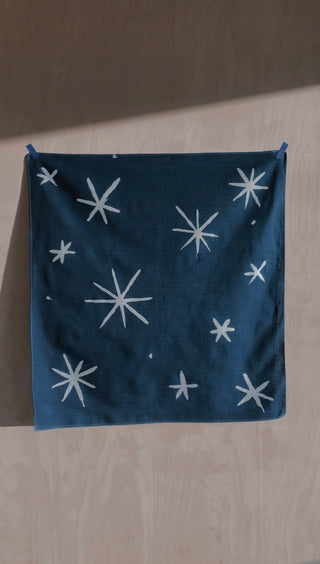Deep blue cloth billows in the breeze, each piece telling a story that spans more than a millennium of Japanese culture. Furoshiki, those versatile wrapping cloths that have graced Japanese households for over 1,300 years, represent more than just a way to carry belongings – they embody an entire philosophy of beauty, functionality, and respect for tradition.
Archaeological findings from the Nara Period (710-794 CE) reveal the earliest forms of furoshiki, then known as "tsutsumi," meaning "to wrap." These cloths were initially reserved for protecting imperial treasures and Buddhist relics. As centuries passed, Japan's evolving social dynamics saw furoshiki adapt and transform. During the Muromachi period (1336-1573), feudal lords began using these cloths in public baths, marking them with family crests to distinguish their belongings. By the time the Edo Period (1603-1867) dawned, furoshiki had woven itself into the fabric of daily life, its name eternally linked to its role in bathhouse culture – "furo" (bath) and "shiki" (to spread).
The Sacred Blue: A Journey Through Indigo's History
The story of indigo dye flows like a river through human civilization, leaving its mark on countless cultures. Ancient fragments of indigo-dyed fabric discovered in Egyptian tombs date back to 2400 BCE, while texts from Mesopotamia speak of "blue gold" being traded along bustling merchant routes. Japanese manuscripts from the Heian period (794-1185) detail the cultivation of the coveted "ai" plant (Polygonum tinctorium), which would become instrumental in Japan's rich textile traditions.
This precious blue dye, primarily extracted from the Indigofera tinctoria plant, transformed the textile world. Historical records from the Dutch East India Company reveal how indigo became one of the most valuable trade commodities along the Silk Road, its worth often exceeding that of spices. In feudal Japan, samurai wore indigo-dyed garments under their armor, believing in the dye's antibacterial properties – a property later confirmed by modern science.
The Alchemy of Blue: Crafting Contemporary Treasures
Creating an indigo-dyed furoshiki requires a delicate dance between science and artistry, a process that has remained largely unchanged for centuries. The journey begins in the indigo vat, where fermented leaves transform into a rich, living solution. Contemporary artisans, like fifth-generation dyer Noguchi Kenichi of Tokushima, speak of indigo as a living entity that must be nurtured and understood.
The dyeing process itself is rhythmic and meditative. Each piece of cotton must be carefully prepared, then submerged in the indigo vat multiple times. Between dips, the fabric oxidizes in the air, gradually building layers of color that shift from green to blue before our eyes. This transformation echoes the Japanese concept of "aizome" – not just the act of indigo dyeing, but a philosophy that embraces patience, precision, and respect for natural processes.
Artisan of the modern era: Ellie Evelyn Orrell
In the verdant landscape of Wales, Ellie Evelyn Orrell continues a rich textile tradition learned at the hands of her mother, Jeanette Orrell. Jeanette, who studied under master dyers on a farm nestled in the foothills of Mt. Fuji, passed down her intricate knowledge of indigo dyeing to her daughter. Together, they maintain an indigo workshop where Jeanette's expertise and Ellie's creative vision converge, transforming traditional techniques into contemporary art.
Traditional furoshiki patterns carry deep symbolic meaning, each design carefully chosen to convey specific wishes or values. The asanoha (hemp leaf) pattern, found in textiles dating back to the Heian period, represents growth and resilience. The seigaiha (wave) pattern, which appears in eighth-century imperial court documents, symbolizes power and surging good fortune. Contemporary artisans often incorporate these historical motifs while adding their own creative interpretations.
In our SOAPSTAR x Ellie Evelyn Orrell collaboration, the furoshiki were meticulously hand-painted by Ellie during a crisp weekend just before the first snow blanketed the Welsh landscape and winter settled in. These pieces feature a signature addition of hand-painted stars that draw inspiration from Japanese symbolism. In this cultural tradition, stars (hoshi) embody guidance and divine protection, deeply rooted in the Tanabata festival where people write wishes on delicate paper and suspend them from bamboo branches beneath the celestial canvas. Each carefully placed star harmonizes with the organic variations of the indigo dye, weaving a narrative that bridges earthly craftsmanship with celestial imagination, capturing a fleeting moment of creative energy before the winter's quiet descended.
For sustainable living
In an age of environmental consciousness, furoshiki offers more than aesthetic appeal. Historical records show that these cloths were among Japan's earliest examples of sustainable design, with single pieces often serving multiple generations. The natural properties of indigo-dyed cotton – its antibacterial qualities, durability, and ability to age gracefully – make these pieces particularly well-suited to modern sustainable lifestyles.
Caring for an indigo-dyed furoshiki connects us to centuries of textile wisdom. Traditional care methods, documented in Edo-period household guides, remain relevant today: gentle hand washing in cold water, natural drying away from direct sunlight, and mindful storage that allows the fabric to breathe. These practices not only preserve the furoshiki but honor the careful work that created it.
The paths of furoshiki and indigo dyeing have intertwined through centuries, creating a legacy that speaks to both practicality and profound beauty. Whether serving as a gift wrap, a bag, or a decorative piece, each furoshiki carries within its folds a story of cultural exchange, artistic innovation, and environmental harmony. In choosing these pieces, we don't just select a beautiful accessory – we become part of an unbroken chain of tradition that stretches back through time, while looking forward to a more sustainable and mindful future.
Buy SOAPSTAR x Ellie Evelyn Orrell handpainted indigo Furoshiki here





